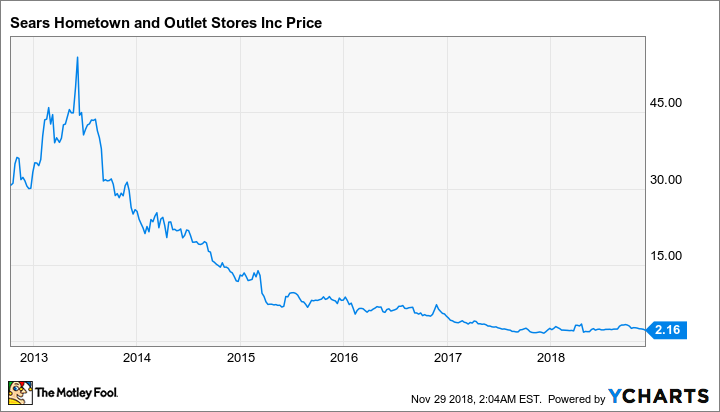Six years ago, Sears Holdings (SHLDQ +0.00%) spun off its mostly franchised small-town stores and its outlet stores as a separate publicly traded company: Sears Hometown and Outlet Stores (SHOS +0.00%).
Shares of the spinoff debuted at around $30 and prospered briefly, but it has been almost all downhill for the past five years. A combination of pricing pressure in Sears Hometown's core appliance market and general retail malaise has led to a long string of losses. For most of 2018, Sears Hometown and Outlet Stores stock has been trading for around $2.
Sears Hometown and Outlet Stores Stock Performance, data by YCharts.
Results have finally started to improve in 2018, raising the hopes of some Sears Hometown shareholders. However, Sears Holdings' recent bankruptcy filing represents a new blow that Sears Hometown and Outlet Stores may not be able to recover from.
The case for Sears Hometown and Outlet Stores
Bulls often point out that Sears Hometown and Outlet Stores shares trade at a steep discount to book value. The company's market cap has hovered around $50 million recently, whereas its book value was $155 million as of early August. In theory, shareholders could earn big profits if the company were to simply wind down its business in an orderly fashion and convert its inventory and other assets to cash.
That said, book value was more than $400 million as recently as early 2015. Big losses between 2015 and 2017 destroyed most of that value. This highlights the importance of returning to profitability sooner rather than later.
Fortunately, Sears Hometown and Outlet Stores seems to be on the right track. It has adjusted its pricing strategy and renegotiated some supply contracts to boost gross margin. The company has also been working to cultivate an identity independent from its former parent, including a national advertising campaign highlighting the local ownership of most of its stores.
These efforts seem to be gaining traction. In the first half of fiscal 2018, Sears Hometown and Outlet Stores' adjusted EBITDA jumped to $14 million from a $6 million loss a year earlier, while its net loss narrowed to $19 million from $51 million. Yet the Sears bankruptcy could quickly stamp out this momentum for two key reasons.

Sears doesn't own the Sears Hometown chain anymore -- but do customers know that? Image source: Sears Holdings.
The company is still highly dependent on Sears
The first reason is that there are still numerous linkages between the two companies. On the plus side, Sears Hometown is near the end of a multiyear process of building out its own IT capabilities.
On the other hand, while the company has been working to sign direct supply agreements with vendors, it still bought 78% of its merchandise from Sears Holdings last year (down from 80% in fiscal 2016). That likely reflects the prominence of Kenmore appliances and Craftsman tools in Sears Hometown's merchandise mix. Indeed, the appliance and tool categories accounted for 77% of sales in the first half of fiscal 2018.
For the moment, Sears Holdings is operating normally despite filing for bankruptcy. That said, liquidation is a possible outcome -- and could come as soon as the first half of 2019. This would force Sears Hometown to scramble to find new suppliers. It would also lose the purchasing power of Sears Holdings, which currently supplies it with merchandise at cost. As a result, Sears Hometown might have to pay more for merchandise, crimping its profitability.
Even if Sears Holdings stays in business, its financial position is likely to remain tenuous. It has tried to save money by slashing its marketing budget to the bone. That means less exposure for the Kenmore and Craftsman brands, which has weighed on sales at Sears Hometown and Outlet Stores over the past year or so.
Do customers understand the difference?
The intangible aspects of the Sears Holdings bankruptcy could have just as big an impact on Sears Hometown as the more practical issues. The bankruptcy filing was national news, due to the company's history as one of the pioneers of retail in the United States. The distinction between Sears Holdings and Sears Hometown and Outlet Stores is a far subtler point -- one that even major media outlets have overlooked at times.
As a result, customers may not realize that the Sears Holdings bankruptcy doesn't directly impact Sears Hometown or Sears Outlet stores. That could make them nervous to shop there.
Of course, Sears Hometown and Outlet Stores is likely to continue advertising its independence from Sears Holdings -- and the mostly franchised nature of the Hometown chain. But it could be forced to substantially increase its marketing spending just to avoid losing customers. That's an expense it can't really afford, given that the company still hasn't reached breakeven.
Secular trends aren't favorable, either
Aside from the headwind created by the Sears bankruptcy, the Sears Hometown chain is likely to face competitive pressure from the growth of e-commerce. Historically, the chain's competitive advantage has been that many of its stores are the only game in town.
E-commerce has given consumers more options. While appliance sales haven't moved online as quickly as other merchandise categories, it's reasonable to assume that people will become more comfortable buying appliances online over time. That means Sears Hometown could face withering competition from larger retailers with far greater purchasing scale.
The Sears Outlet segment is more promising, due to its dominant position in the "as is" appliance clearance business. However, it represents less than a third of the company's total revenue. Between the near-term headwinds from the Sears Holdings bankruptcy and the uncertain future of the Sears Hometown business, investors should probably steer clear of Sears Hometown and Outlet Stores stock -- even though it is trading for a fraction of book value.




